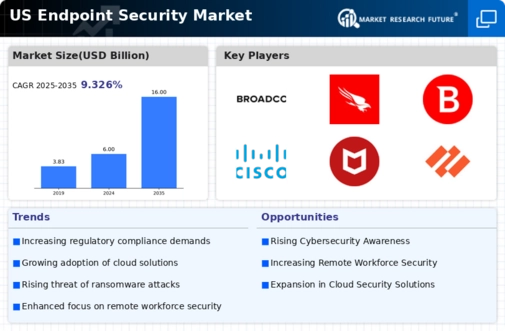Remote Work and BYOD Policies
The shift towards remote work and the adoption of Bring Your Own Device (BYOD) policies have significantly impacted the endpoint security market. As more employees work from home, the number of devices accessing corporate networks has increased, creating new vulnerabilities. According to recent studies, organizations that implement BYOD policies without adequate security measures face a 30% higher risk of data breaches. Consequently, businesses are compelled to invest in comprehensive endpoint security solutions that can effectively manage and secure diverse devices. This trend underscores the necessity for organizations to adapt their security strategies, thereby propelling the endpoint security market forward.
Increasing Cyber Threat Landscape
The endpoint security market is experiencing heightened demand due to the increasing cyber threat landscape in the US. Organizations are facing a surge in sophisticated cyberattacks, including ransomware and phishing schemes, which have prompted a reevaluation of security protocols. In 2025, it is estimated that cybercrime will cost businesses globally over $10 trillion annually, with a significant portion of these attacks targeting endpoints. As a result, companies are investing heavily in advanced endpoint security solutions to protect sensitive data and maintain operational integrity. This trend indicates a growing recognition of the need for robust security measures, thereby driving growth in the endpoint security market.
Regulatory Compliance Requirements
Regulatory compliance requirements are becoming increasingly stringent, compelling organizations to enhance their endpoint security measures. In the US, regulations such as the Health Insurance Portability and Accountability Act (HIPAA) and the General Data Protection Regulation (GDPR) impose strict guidelines on data protection. Non-compliance can result in hefty fines, reaching up to $20 million or 4% of annual global turnover, whichever is higher. As a result, businesses are prioritizing investments in endpoint security solutions to ensure compliance and protect sensitive information. This growing emphasis on regulatory adherence is a key driver of the endpoint security market, as organizations seek to mitigate risks associated with non-compliance.
Rising Awareness of Cybersecurity Risks
There is a growing awareness of cybersecurity risks among organizations, which is significantly influencing the endpoint security market. As high-profile data breaches make headlines, businesses are increasingly recognizing the importance of safeguarding their digital assets. Surveys indicate that over 70% of organizations consider cybersecurity a top priority, leading to increased investments in endpoint security solutions. This heightened awareness is driving demand for advanced technologies, such as threat detection and response systems, which are essential for mitigating risks. Consequently, the endpoint security market is poised for growth as organizations strive to enhance their security posture in response to evolving threats.
Adoption of Cloud-Based Security Solutions
The increasing adoption of cloud-based security solutions is reshaping the endpoint security market. Organizations are increasingly migrating to cloud environments, which necessitates the implementation of robust security measures to protect endpoints. In 2025, it is projected that the cloud security market will reach $12 billion, reflecting a growing trend towards cloud-based solutions. This shift is driven by the need for scalability, flexibility, and cost-effectiveness in security measures. As businesses recognize the advantages of cloud security, they are likely to invest in endpoint security solutions that integrate seamlessly with cloud infrastructure, thereby fostering growth in the endpoint security market.

















Leave a Comment